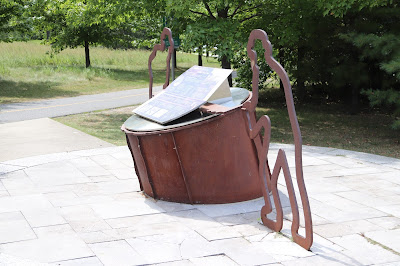A plaque about lumber in Ottawa occupies a place on the south shore of the Ottawa River, north of the Ottawa River Pathway, and west of where Booth Street changes to Chaudière Crossing.
Lumber: Wealth of the Hinterland
THE EMERGENCE OF A NATIONAL INDUSTRY
International events coincided with the development of regional resources at the start of the 19th century, to give birth to one of Canada's first national industries in the Ottawa area: the lumber industry.
Le bois : richesse des lieux
LA NAISSANCE D'UNE INDUSTRIE NATIONALE
Au début du 19e siècle, certains événements sur la scène internationale ont coïncidé avec le développement régional des ressources pour donner naissance à l'une des premières industries nationale du Canada dans la région d'Ottawa : l'industrie du bois.
Loading squared timber into sailing vessels at the port of Québec, 1872.
Notman Photographic Archives, McCord Museum, 176322
Chargement de bois équarri dans les navires à voiles au port de Québec, en 1872.
Archives photographiques Notman, Musée McCord, 176322
Les photos ci-dessous illustrent différents étapes du travail du bûcharon au 19e siècle dans la vallée de l'Outaouais.
THE CUT
To fell the tree, lumbermen worked in teams of two, using a two-man crosscut saw.
Library and Archives Canada, PAC C26244
LA COUPE
Pour abattre un arbre, les bûcherons travaillaient en équipe de deux, utilisant un passe-partout.
Bibliothèque et Archives Canada, PAC C26244
The trees were limbed and measured. The key criteria for cutting a tree into logs for export were its straightness and quality as well as the absense of knots and other damage.
Library and Archives Canada, PAC-C25719
LES BILLES
On ébranchait les arbres et on en mesurait les troncs. Pour couper un arbre en billes destinées à l'exportation, il fallait qu'il soit droit et que le bois soit de bonne qualité, il ne devait pays y avoir de nœuds ni d'autres imperfections.
Bibliothèque et Archives Canada, PAC-C25719
SQUARING THE TIMBER
Using a broadaxe, the team hewed the logs on four sides to create a squared, smooth surface with bevelled ends that resembled a pyramid shape. Lumbermen saw squaring as an art that required skill and experience. Some lunbermen even engraved their names, like artists on their "work."
Library and Archives Canada, C75265
ÉQUARRISSAGE DU BOIS
Utilisant une doloire (ou « épaule de mouton »), les hommes taillaient les billes à angles droits pour créer une forme carrée, rendaient les surfaces bien lisses puis taillainet les extrémités en biseau. Les bûcherons voyaient l'équarrisage comme un art qui nécessiait habileté et expérience. Certains d'entre eux gravaient même leur nom sur leur « œuvre », comme le font les artistes.
Bibliothèque et Archives Canada, C75265













